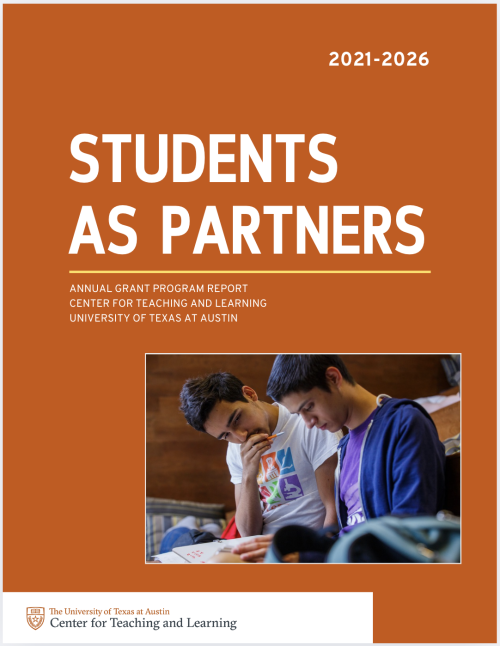
Photo by Headway on Unsplash
"Students as partners" repositions students as collaborators in the processes of teaching and learning, empowering students to be actively engaged in, and share the responsibility for, the experience of learning as agents in the construction of it.
An in-depth exploration of "students as partners" can be found in the following Higher Education Academy (UK) report, "Engagement through partnership: students as partners in learning and teaching in higher education" (Healy, et. al., 2014). Healey characterizes "students as partners" projects as facilitating “a relationship in which all involved – students, academics, professional services staff, senior managers, students’ unions, and so on – are actively engaged in and stand to gain from the process of learning and working together” (2014, p. 12). Partnering with students in the development of the teaching and learning environment is a meaningful opportunity to develop important academic and transferable skills as well as foster a student-centered learning environment. As such, the partnership program seeks to engage students in different projects and activities, including, but not limited to:
- Co-designing and contributing to the development of courses and curriculum.
- Offering in-depth feedback around issues related to classroom instructional approaches.
- Helping design course materials such as assessments, content within Canvas sites, and multimedia tools.
- Formatting and preparing assessments.
- Incorporating educational technologies, whether online or face-to-face.
- Designing and working on a limited Scholarship of Teaching and Learning (SoTL) project that can be developed over a term or year.
What does "students as partners" work look like?
While students as partners work can take many different forms, the focus must be fundamentally and rigorously collaborative, one that examines perceived hierarchies between instructors and students with the aim of creating learning environments characterized by discovery, self-awareness, and sense of belonging.” In addition, the way in which this work is represented must also include a plurality of voices: faculty members or instructors and students must both contribute to the realization and dissemination of "students as partners" work.
Deakin University’s annual case studies of students as partners initiatives and Elon University’s open publication "The Power of Partnership," written from both the instructional and student perspectives, offer insights into the value of students as partners initiatives.
What are the benefits of engaging in "students as partners" projects?A review of 65 empirical studies (PDF, 1.1MB), as outlined by the The University of Queensland's Institute for Teaching and Learning Innovation, published on Students as Partners in university teaching and learning (2011 to 2015) reported a range of beneficial outcomes for both students and instructors. For students:
For instructors:
|
How should we identify potential "students as partners" projects?

While many of us feel that we are already working with students as partners, the specific framework of "students as partners" encourages us to adopt an intentional and deep collaborative stance with and towards our students. The article, "Five Propositions for Genuine Students as Partners Practice" (Matthews, 2017), provides a good primer on how to approach this work. The five interrelated principles for good practice in partnership guide meaningful, power-sharing, and influential approaches across a diverse range of institutional and "students as partners" contexts: 1. Foster partnerships Ideally, institutions will direct attention to the experiences of students as the focus of partnership work and investigate how instructors and students can work together. 2. Nurture power-sharing relationships through dialogue and reflection Power, whether discussed or left unspoken, is always a factor in student-instructor partnership interactions. 3. Accept partnership as a process with uncertain outcomes Partnership is defined by the process of working together. As such, the outcomes of students and instructors engaging as partners may be unknown at the beginning of the joint endeavor but that allows for unique insights to be gained. 4. Engage in ethical partnerships Engaging in partnership should be governed by ethical guidelines: who benefits from the work and how? 5. Enact partnership for transformation Transformation begins through our own active reflection and ongoing dialogue with others about who engages and why in partnership, what it means for higher education, and how we advocate for "students as partners" more widely. |
Research / Examples of Practice
- Many of the elements of the CTL's "Students as Parnters" Initiative are explicitly based on the exemplary work of the "Students as Partners" initiative at the University of Queensland, as headed by Dr. Kelly Matthews.
- International Journal for Students as Partners - Free, open-access journal documenting research and practice
- A Systematic Literature Review of Students as Partners in Higher Education
- International case studies of partnership in practice - Mick Healey hand-out on 'students as change agents'
- Teaching and Learning Together in Higher Education - Reflective essays on partnership practices
- Engaging Students as Partners: A guide for faculty - A guide to developing productive student-faculty partnerships in higher education
- Co-designing a Community of Practice for Students as Partners in Partnership


